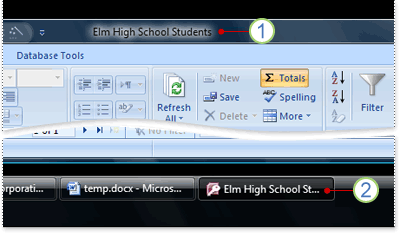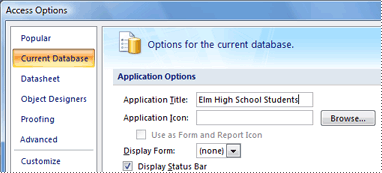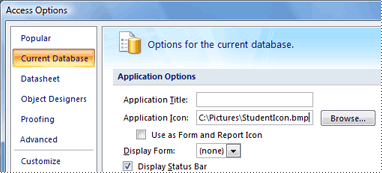Add a custom title or icon to a database
Customizing your Microsoft Office Access database with a meaningful title or icon can help make it easier for users to identify the database.
What do you want to do?
Add a custom title
The application title is the text that appears in the title bar of the Access window and on the Windows taskbar button for the database.

1. Title bar
2. Taskbar button
If you do not enter a custom title for your database, Access displays a default title that is based on the file name of the database. For example, for a database file called Students.accdb, the default, title bar text is Students : Database (Access 2007) - Microsoft Access. The default, taskbar button text, as well as the text that displays when you press ALT+TAB to switch between windows, is Microsoft Access - Students : Database (Access 2007). Specifying a custom title enables you to replace that text with more meaningful text, such as Elm High School Students.
Note: Adding a custom title does not change the file name of the database.
-
Click the Microsoft Office Button
 , and then click Access Options.
, and then click Access Options. -
Click Current Database.
-
Under Application Options, in the Application Title box, type the title that you want to be displayed.

Add a custom icon
An application icon is the small graphic that appears next to the title in the Windows taskbar button for the database. This icon also appears when you press ALT+TAB to switch between windows. By default, Access displays the Access program icon  . Access does not provide any other icons, but you can replace the default icon with one that you created, or one that you obtained from another source.
. Access does not provide any other icons, but you can replace the default icon with one that you created, or one that you obtained from another source.
-
Click the Microsoft Office Button
 , and then click Access Options.
, and then click Access Options. -
Click Current Database.
-
Under Application Options, in the Application Icon box, do one of the following:
-
Type the full path of the icon that you want to be displayed, for example, C:\Pictures\StudentIcon.bmp.
-
To browse to the file location of your icon, click Browse.

Note: Valid file types include icon (*.ico), cursor (*.cur), and bitmap (*.bmp).
-
-
To display the icon on the document tab of each form or report, or in the title bar of the form or report if overlapping windows are used, select the Use as Form and Report Icon check box.
No comments:
Post a Comment